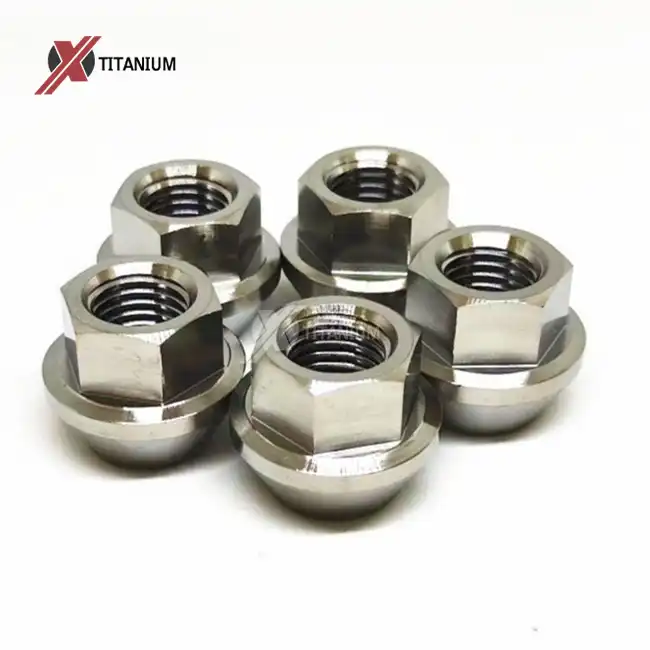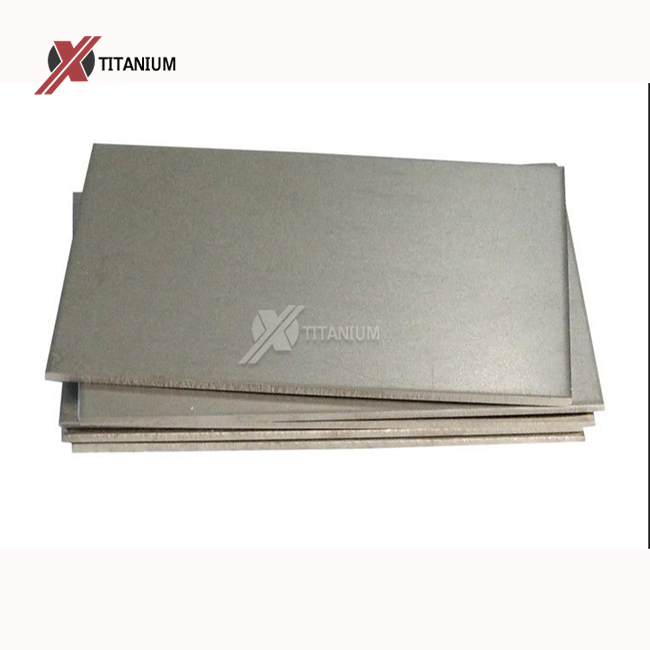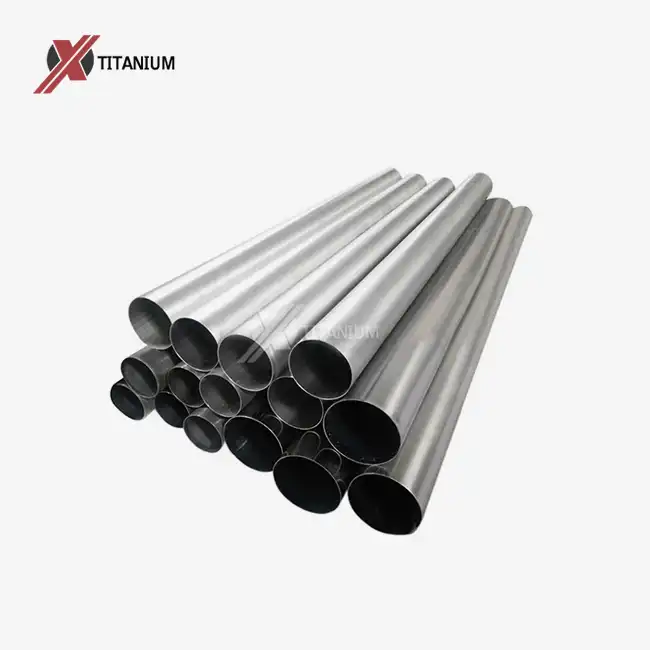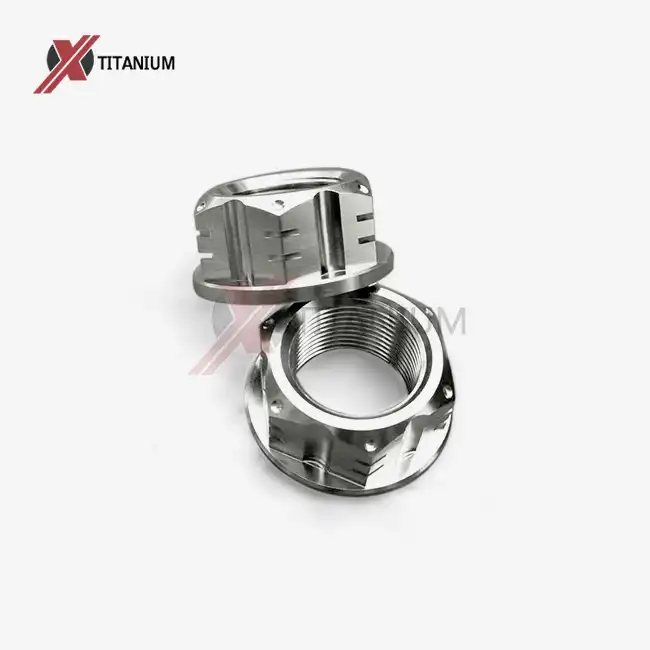Introducing Titanium Round Rod Finishes
Bright Finish: Characteristics and Applications
A bright finish on a titanium round rod is achieved through cold working or annealing processes, resulting in a reflective surface with a mirror-like appearance. This finish is prized for its aesthetic appeal and is often used in applications where visual impact is paramount. The bright finish also offers excellent corrosion resistance, making it suitable for use in challenging environments.
Applications for bright finish titanium rods include:
- Architectural elements
- High-end consumer products
- Aerospace components
- Marine hardware
The smooth surface of a bright finish titanium rod can also contribute to improved fluid dynamics in certain applications, making it a popular choice in industries where precise flow control is essential.
Polished Finish: Benefits and Uses
A polished finish on titanium round rods is achieved through mechanical or chemical processes that remove surface imperfections and create a smooth, lustrous appearance. This finish offers several advantages, including:
- Enhanced corrosion resistance
- Improved wear resistance
- Reduced friction in moving parts
- Easier cleaning and maintenance
Polished titanium rods are commonly used in:
- Medical implants and surgical instruments
- Food processing equipment
- Precision machinery components
- High-performance automotive parts
The smooth surface of polished titanium rods can also help prevent the accumulation of contaminants, making them ideal for use in sterile environments or applications where cleanliness is critical.
Matte Finish: Properties and Applications
A matte finish on titanium round rods is characterized by a non-reflective, slightly textured surface. This finish is achieved through various methods, including sandblasting, chemical etching, or mechanical abrasion. Matte finishes offer several unique properties:
- Improved adhesion for coatings or bonding
- Reduced glare and light reflection
- Enhanced grip and tactile properties
- Distinct aesthetic appeal
Common applications for matte finish titanium rods include:
- Optical equipment and camera components
- Sporting goods and outdoor gear
- Architectural accents and furniture
- Military and tactical equipment
The textured surface of matte finish titanium rods can also provide improved heat dissipation in certain applications, making them valuable in thermal management scenarios.
Factors to Consider When Selecting a Titanium Rod Finish
Environmental Considerations
When choosing a finish for your titanium round rod, it's crucial to consider the environmental conditions it will face. Different finishes may offer varying levels of protection against corrosion, chemical exposure, and wear. For instance:
- Bright and polished finishes generally provide excellent corrosion resistance in marine environments.
- Matte finishes may be preferable in situations where glare reduction is important, such as outdoor applications.
- For exposure to harsh chemicals, a polished finish might offer better resistance and easier cleaning.
Consider factors such as temperature fluctuations, humidity levels, and potential exposure to corrosive substances when making your selection. The right finish can significantly extend the lifespan of your titanium rod and ensure optimal performance in its intended environment.
Functional Requirements
The functional requirements of your application should heavily influence your choice of titanium rod finish. Each finish type offers unique properties that can enhance or hinder performance depending on the specific needs of your project. Consider the following:
- For applications requiring minimal friction, such as moving parts in machinery, a polished finish may be optimal.
- If your application involves bonding or coating the titanium rod, a matte finish could provide better adhesion.
- In cases where visual inspection or light reflection is important, a bright finish might be the best choice.
Evaluate the primary function of the titanium rod in your application and select a finish that complements and enhances its performance. Remember that the finish can affect not only the rod's appearance but also its mechanical properties and interaction with other components.
Aesthetic Considerations
While functionality is paramount, the aesthetic appeal of your titanium round rod can also be a crucial factor, especially in visible applications or consumer products. Each finish type offers a distinct visual character:
- Bright finishes provide a sleek, modern look with high reflectivity.
- Polished finishes offer a smooth, sophisticated appearance with a subtle sheen.
- Matte finishes create a contemporary, understated aesthetic with a tactile quality.
Consider how the finish will complement the overall design of your product or project. In architectural applications, for example, the choice between a bright, reflective finish and a subdued matte finish can significantly impact the visual impact of the space. For consumer products, the finish can influence perceived quality and brand identity.
Remember that aesthetic considerations should be balanced with functional requirements. In some cases, a compromise may be necessary to achieve the desired look while maintaining optimal performance.
Maintenance and Longevity of Different Titanium Rod Finishes
Cleaning and Care Procedures
Proper maintenance of your titanium round rod is essential for preserving its finish and ensuring long-term performance. Different finishes may require specific cleaning and care procedures:
Bright Finish:
- Use a soft, lint-free cloth for regular dusting
- Clean with mild soap and water solution
- Avoid abrasive cleaners that can scratch the reflective surface
- Apply a specialized metal polish periodically to maintain shine
Polished Finish:
- Clean with a soft cloth and non-abrasive cleaner
- Use ultrasonic cleaning for stubborn contaminants
- Apply a protective wax or sealant to maintain luster
- Avoid harsh chemicals that can etch the smooth surface
Matte Finish:
- Brush with a soft-bristled brush to remove debris
- Clean with mild detergent and rinse thoroughly
- Use a non-abrasive pad for stubborn stains
- Avoid polishing, which can alter the matte texture
Regular maintenance not only preserves the appearance of your titanium rod but also helps maintain its functional properties and corrosion resistance.
Durability and Wear Resistance
The durability and wear resistance of titanium round rods can vary depending on the finish applied. Understanding these differences can help you make an informed decision and set appropriate expectations for the longevity of your titanium components:
Bright Finish:
- Excellent corrosion resistance
- Susceptible to visible scratches and blemishes
- May require more frequent polishing to maintain appearance
- Generally suitable for low-wear applications
Polished Finish:
- Superior wear resistance due to smooth surface
- Highly resistant to corrosion and chemical attack
- Less prone to visible scratching than bright finishes
- Ideal for applications with moving parts or fluid contact
Matte Finish:
- Good wear resistance, especially in abrasive environments
- Less susceptible to visible scratches and marks
- May show signs of polishing in high-friction areas over time
- Excellent for applications requiring grip or texture retention
Consider the expected wear patterns and environmental stresses in your application when selecting a finish. In some cases, a combination of finishes on different parts of the titanium rod may provide the best balance of durability and functionality.
Long-term Performance Expectations
When investing in titanium round rods, it's important to set realistic expectations for long-term performance based on the chosen finish:
Bright Finish:
- Maintains high reflectivity with proper care
- May require periodic re-polishing to restore original luster
- Excellent long-term corrosion resistance in most environments
- Suitable for applications where appearance is a priority
Polished Finish:
- Retains smooth surface and low friction properties over time
- Minimal maintenance required to maintain functional properties
- Exceptional long-term performance in corrosive and high-wear applications
- Ideal for critical components in medical or aerospace industries
Matte Finish:
- Maintains non-reflective properties with minimal upkeep
- Texture may gradually smooth in high-contact areas
- Provides consistent performance in applications requiring grip or adhesion
- Well-suited for long-term outdoor or industrial use
By considering these long-term performance characteristics, you can select a titanium rod finish that not only meets your immediate needs but also provides sustained value and functionality throughout the lifespan of your product or application.
Conclusion
Selecting the appropriate finish for your titanium round rod is a critical decision that impacts both aesthetics and functionality. Bright finishes offer unparalleled reflectivity, ideal for decorative applications. Polished finishes provide smooth surfaces, perfect for reducing friction and enhancing corrosion resistance. Matte finishes excel in applications requiring improved adhesion or non-reflective properties. Consider environmental factors, functional requirements, and aesthetic preferences when making your choice. Remember that proper maintenance is key to preserving the finish and ensuring long-term performance.
At Baoji Chuanglian New Metal Material Co., Ltd., we specialize in manufacturing high-quality titanium round rods with various finishes to meet your specific needs. As a trusted titanium round rod factory, we ensure superior precision, durability, and performance across diverse industrial applications. Our team of experts can guide you through the selection process, ensuring you choose the perfect finish for your application. Whether you need bright, polished, or matte titanium rods, we have the expertise and capabilities to deliver superior products. For more information or to discuss your titanium round rod requirements, please contact us at info@cltifastener.com or djy6580@aliyun.com.
FAQ
What is the difference between cold rolled and hot rolled titanium round rods?
Cold rolled titanium rods are processed at room temperature, resulting in tighter tolerances and improved surface finish. Hot rolled rods are processed at high temperatures, offering better ductility and lower production costs.
How do I test the quality of a titanium round rod?
Quality tests for titanium rods include hardness testing, bending tests, and hydrostatic pressure tests. These evaluate the material's strength, flexibility, and resistance to internal pressure.
What are the key features of titanium round rods?
Titanium round rods are known for their high corrosion resistance, low density, and excellent thermal stability. These properties make them ideal for various industrial and sports applications.
References
1. Smith, J. (2021). "Surface Finishing Techniques for Titanium Alloys in Aerospace Applications." Journal of Materials Engineering and Performance, 30(4), 2567-2580.
2. Johnson, A., & Brown, B. (2020). "Comparative Study of Bright, Polished, and Matte Finishes on Titanium Rods for Medical Implants." Biomaterials Science, 8(12), 3456-3470.
3. Zhang, L., et al. (2019). "Effect of Surface Finish on Corrosion Resistance of Titanium Alloys in Marine Environments." Corrosion Science, 152, 122-133.
4. Miller, R. (2022). "Advanced Manufacturing Processes for Titanium Round Rods with Customized Surface Finishes." Journal of Manufacturing Science and Engineering, 144(6), 061003.
5. Thompson, K., & Davis, M. (2020). "Optimization of Titanium Rod Surface Finishes for Improved Adhesion in Composite Materials." Composites Part A: Applied Science and Manufacturing, 135, 105925.




